| This page is currently undergoing a major edit by Dser.
As a courtesy, please do not edit this page while this message is displayed. If you have any suggestions for the editor, please post them on this article's talk page. |
| Half dollar | |||
|---|---|---|---|
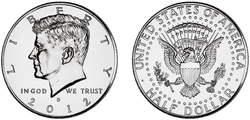
| |||
| 2012 coin | |||
| General information | |||
| Country | |||
| Value |
$0.50 | ||
| Years |
1794–present | ||
| Measurements and composition | |||
| Mass |
| ||
| Diameter |
| ||
| Composition |
| ||
| Appearance | |||
| Shape |
round | ||
| Alignment |
coin | ||
| Obverse |
| ||
| Reverse |
| ||
| v · d · e | |||
The half dollar coin, sometimes referred to as the 50 cent coin or 50 cent piece, has been produced nearly every year since the establishment of the United States Mint in 1794. Today the coins are still issued, but are not commonly circulated.
General history[]

|
| The Coinage Act of 1792 authorized issuance of the half dollar. |
The first recorded proposal of the United States developing a decimal-based currency system was made in 1873 by Benjamin Franklin, Alexander Hamilton, Thomas Jefferson, and David Rittenhouse. Hamilton, who was the first Secretary of the United States Treasury, recommended the issuance of such coins in 1791, in a report to Congress, the half dollar being one of six coins Hamilton proposed. The Coinage Act of 1792 was passed a year later, and authorized the production of a coin "half the value of the dollar or unit" that was mandated to "contain one hundred and eighty-five grains and ten sixteenth parts of a grain of pure, or two hundred and eight grains of standard silver".
From 1794 to 1837, the half dollar was composed of 89.2% silver and 10.8% copper, weighed 13.48 grams, and measured 32.5 millimeters in diameter. The silver content was increased to being .900 fine in 1838, but to maintain the intrinsic value of the initial issues, the half dollar's mass was lowered to 13.36 grams and its diameter was reduced to 30 millimeters. With the introduction of the Seated Liberty half dollar in 1839, the diameter was slightly increased to 30.6 millimeters. The mass was subsequently reduced to 12.44 grams in 1853, and then increased to 12.5 grams in 1873.
With the passage of the Coinage Act of 1965, most silver coins issued by the United States became replaced by cupronickel alternatives. However, the half dollar was authorized to be struck in .400 fine silver until 1970. It retained the original 30.6 millimeter diameter, but the coin's mass was reduced to 11.5 grams. The cupronickel half dollar, weighing 11.34 grams and measuring 30.6 millimeters in diameter, was first issued in 1971 and has been minted nearly every year since. Silver proof half dollars for collectors commenced issuance in 1992, and are currently produced by the United States Mint.
The first commemorative half dollar was issued in 1892. Thenceforth, the denomination has become common for U.S. commemorative coins.
Circulation[]

|
This page uses Creative Commons Licensed content from Wikipedia (view authors). |
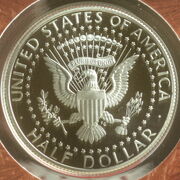
A 2009 proof half dollar.
Half dollars saw heavy use, most notably during the first half of the 20th century. For several years, they were commonly used in casinos. Some slot machines took in and paid out 50 cent pieces; however, casinos in recent years have introduced "coinless" slots for all denominations, taking in paper money and rewarding winning players with vouchers. Nowadays, some cardrooms keep rolls of half dollars on hand for games requiring 50 cent antes or bring-in bets, for dealers to pay winning naturals in blackjack, or when the house collects a rake in increments of 50 cents.
The 1964 Kennedy half dollars were massively saved from circulation for sentimental reasons. Those issued during the later years of the 1960s were hoarded as the only precious metal U.S. coins remaining in production, and as silver prices rose, pre-1964 half dollars disappeared from circulation as well. By the time the silver coins became replaced by cupronickel alternatives to match the dime and quarter in 1971, businesses and the public had adapted to a country in which the half dollar did not commonly circulate. The quarter then took over the half dollar's role as the highest-valued generally issued component of change.
Most half dollars nowadays enter circulation through the change drawers of businesses. Even though by law, half dollars are legal tender, few businesses stock their change drawers with them, as a result of the coin's deprecation. Furthermore, many banks do not stock half dollars or hand them out as a normal practice, and thus, the coins do not see much circulation.
Most U.S. vending machines do not accept half dollars, nor do payphones, which further limits the coin's circulation. However, sleight of hand magicians specializing in coin magic prefer the half dollar for its size and weight.
Recently, half dollar coins have been minted strictly for collectors, due to a large Federal Reserve and governmental inventories on hand of pre-2001 pieces, as a result of the lack of demand and large quantity returns from casino slot machines that now operate "coinless". When the reserve supply of half dollars runs low, the mint will again fill orders for half dollars intended for circulation. Modern-date halves can be purchased in proof sets, mint sets, rolls, and bags from the United States Mint, and existing inventory circulation coins can be bought from most banks in the U.S. All collector issues since 2001 have had lower mintages than in previous years, and even though they are intended for collection purposes, they occasionally find their way into circulation.
Design history[]
Flowing Hair half dollar[]
- Main article: Flowing Hair
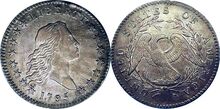
1795 Flowing Hair coin.
The Flowing Hair half dollar was among the first silver coins put into circulation within the United States, and was produced until 1795. Like the other coins issued in the U.S. during the time, it was designed by Chief Engraver Robert Scot. The Flowing Hair half dollar featured a right-facing bust of Liberty on the obverse, flanked by fifteen six-pointed stars representing the states. Above the image was a caption that read "LIBERTY", and below it was the date. A slender eagle was displayed on the reverse, encircled by branches, which surrounded in turn by an inscription reading "UNITED STATES OF AMERICA". Along the edge was inscription that read "FIFTY CENTS OR HALF A DOLLAR", referring to the coin's value. Only 23,464 examples were struck by the Philadelphia Mint in 1794, compared to the 299,680 minted in 1795.
All Flowing Hair half dollars were hand-engraved, and thus, several varieties are currently known to exist. "United States Early Half Dollar Die Varieties 1794-1836" by Donald L. Parsley lists ten 1794 varieties and thirty-two 1795 varieties. The two most notable 1795 varieties are the standard 1795 half dollar and the "3 leaf" variety, which shows three leaves under the wings of the eagle on the reverse, as compared to the two leaves on the standard variety.
Draped Bust half dollar[]
- Main article: Draped Bust

1797 half dollar
The Draped Bust series of United States coinage was introduced in 1795. However, the first Draped Bust half dollar was not introduced until a year after the series' debut, in 1796, and was issued thenceforth until 1797, and then from 1801 to 1807. A new right-facing depiction of Liberty was displayed on the obverse, which, like the previous issue, was designed by Chief Engraver Robert Scot. Above the bust was an inscription that read "LIBERTY", and below it was the year. Fifteen stars surrounded Liberty on the 1796 pieces, but with Tennessee's admission to the Union later that year, the number of stars was increased to sixteen in 1797. The reverse of the initial issues of the Draped Bust half dollar was nearly identical to that of the precedent Flowing Hair coins. It featured a similar eagle encircled by laurel branches, which were in turn surrounded by the full title of the United States (UNITED STATES OF AMERICA). However, directly underneath the eagle and branches on the 1796 and 1797 half dollars was a fraction (½) that represented the coin's value. Only 3918 examples of 1796 and 1797 Draped Bust half dollars are known to exist.
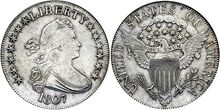
1807 half dollar
No half dollars were struck from 1798 to 1800, but production of the Draped Bust coin recommenced in 1801. The obverse of the new issue was nearly identical to that of the earlier Draped Bust issues, but the amount of stars present was reduced to thirteen to signify the original Thirteen Colonies. The reverse, designed by John Eckstein, was almost entirely altered. The original "UNITED STATES OF AMERICA" inscription was still present, but the eagle, originally criticized for its scrawny appearance, as well as the laurel branches and fraction were replaced by a larger eagle with a shield on its breast holding thirteen arrows in its dexter talon, an olive branch in its sinister talon, and a scroll bearing the motto E PLURIBUS UNUM in its beak. Along the coin's edge was lettering that read "FIFTY CENTS OR HALF A DOLLAR". At least 1,600,787 Draped Bust half dollars were struck between 1801 and 1807.
Capped Bust half dollar[]
- Main article: Capped Bust
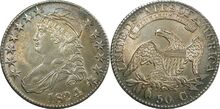
1824 half dollar
The Capped Bust half dollar debuted in 1807, and was issued until 1839. It was designed by German-born engraver John Reich, a subordinate of Robert Scot. A left-facing curly-haired depiction of Liberty wearing a Phrygian cap with her name inscribed on the headband was displayed on the obverse, flanked by seven six-pointed stars to the left of the image and six to the right. The year was written underneath the bust. An eagle bearing a shield on its breast holding an olive branch in its dexter talon and three arrows in its sinister talon was engraved on the reverse. Above the eagle was a scroll bearing the motto "E PLURIBUS UNUM" and a curved legend reading "UNITED STATES OF AMERICA", and below it was an inscription indicating the coin's value, written as "50 C.". Between 1807 and 1836, at least...
Seated Liberty half dollar[]
The Seated Liberty Half Dollar was a 50-cent coin struck from 1839 to 1891. Many dates in the series are very easy to find, but there are many key dates that exist, such as any 1880s half dollar and the ever-popular 1878-S half dollar.
